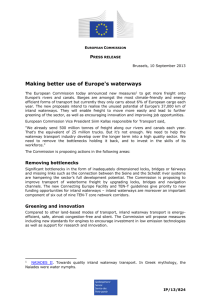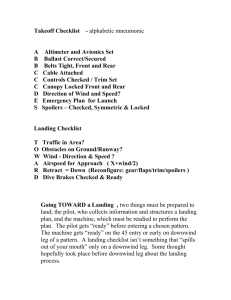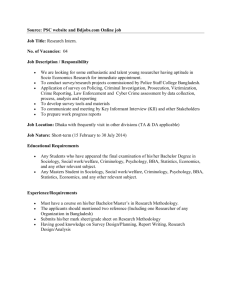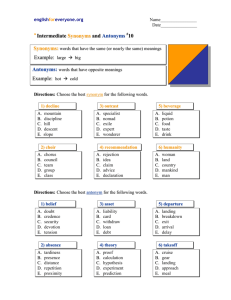Document
advertisement
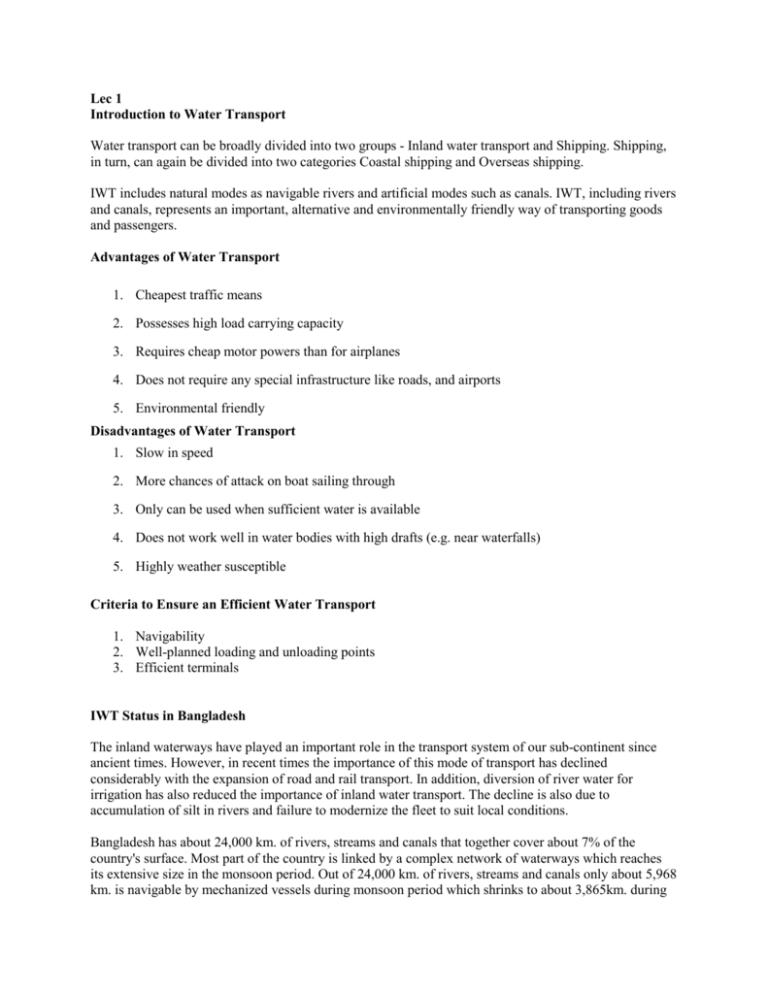
Lec 1 Introduction to Water Transport Water transport can be broadly divided into two groups - Inland water transport and Shipping. Shipping, in turn, can again be divided into two categories Coastal shipping and Overseas shipping. IWT includes natural modes as navigable rivers and artificial modes such as canals. IWT, including rivers and canals, represents an important, alternative and environmentally friendly way of transporting goods and passengers. Advantages of Water Transport 1. Cheapest traffic means 2. Possesses high load carrying capacity 3. Requires cheap motor powers than for airplanes 4. Does not require any special infrastructure like roads, and airports 5. Environmental friendly Disadvantages of Water Transport 1. Slow in speed 2. More chances of attack on boat sailing through 3. Only can be used when sufficient water is available 4. Does not work well in water bodies with high drafts (e.g. near waterfalls) 5. Highly weather susceptible Criteria to Ensure an Efficient Water Transport 1. Navigability 2. Well-planned loading and unloading points 3. Efficient terminals IWT Status in Bangladesh The inland waterways have played an important role in the transport system of our sub-continent since ancient times. However, in recent times the importance of this mode of transport has declined considerably with the expansion of road and rail transport. In addition, diversion of river water for irrigation has also reduced the importance of inland water transport. The decline is also due to accumulation of silt in rivers and failure to modernize the fleet to suit local conditions. Bangladesh has about 24,000 km. of rivers, streams and canals that together cover about 7% of the country's surface. Most part of the country is linked by a complex network of waterways which reaches its extensive size in the monsoon period. Out of 24,000 km. of rivers, streams and canals only about 5,968 km. is navigable by mechanized vessels during monsoon period which shrinks to about 3,865km. during dry period. The IWT sector carries over 50% of all arterial freight traffic and one quarter of all passenger traffic. Length of inland waterways Length of navigable waterways Monsoon Dry season Least available depth range Annual water discharge (Source:BWDB) Annual quantum of silt (Source: BWDB) No. of passenger carried (In year) Quantum of cargo carried (In year) 24,000 km. 5968 km. 3865 km. 3.90 m to 1.50 m. 1400 billion cubic meter. 2.5 billion tons. 87.80 million. 0.58 million ton. The waterways of Bangladesh have been classified into four categories depending on least available depth (LAD) ranging from 3.90 m to 1.50m. Name of Route Minimum Depth Length of Route and Percentage 683 km (11.39%) Minimum Vertical Clearance 18.30 m Minimum Horizontal Clearance 76.22 m Class- I 3.66 m Class- II 2.13 m 1027 km(17.13%) 12.20 m 76.22 m Class -III 1.52 m 1885 km(31.44%) 7.62 m 30.48 m Class -IV Less than 1.52 m 2400 km(40.04%) 5.00 m 20.00 m Protocol on Inland Water Transit and Trade between Bangladesh and India. To utilize the rivers for transportation of goods between the two countries and for transportation of goods from one Indian place to another Indian place, there exists a Protocol on Inland Water Transit and Trade between Bangladesh and India. The current protocol is valid upto 31st March, 2009. To transport the inter-country trade cargo following ‘Ports of Call’ have been designated under the Protocol: Bangladesh India Narayanganj Kolkata Khulna Haldia Mongla Pandu Sirajganj Karimganj Under the Protocol, eight IWT routes have been designated for the porpose of transport. Following are the main transit routes: a) Kolkata – Pandu b) Kolkata – Karimganj c) Karimganj - Pandu Bangladesh Inland Water Transport Authority (BIWTA) have been appointed by the Government as Competent Authority for all working under the Protocol, while Inland Waterways Authority of India (IWAI) by the Indian Government. Number of trips on inter Country Trade under the Protocol Since 2006-2007 to 2009-2010 (March) Year Round Trip by Bangladeshi vessels Round Trip by Indian vessels Total Under Protocol Route 2006-2007 2,540 00 2,540 2007-2008 2,976 02 2,980 Oct' 2008- June' 2009 1,031 11 1,042 7 1,308 July' 2009 - March' 2010 1301 Statistics of Inter-country cargo carried by Bangladesh and India vessels in metric ton and Ratio since 2006- 2007 to March-2010 Year Carried by Bangladeshi vessels (M.ton) Carried by Indian vessels (M.ton) Total carried (M.ton) Percentage (Bangladesh : India) 1 2 3 2+3 2006-2007 8,81,011 -- 8,81,011 100 : 00 2007-2008 9,94,345 1,900 9,96,245 99.80 : 0.20 2008-2009 9,30,094 14,328 9,44,422 98.48 : 1.52 3,591.74 9,53,700.74 99.62 : 0.38 July' 2009 - March' 2010 9,50,109 Statistics of transit trade cargo transported under the Protocol on IWT & T between Bangladesh and India (in M.ton)* Name of Route 2007-08 2008-09 2009-March'2010 Kolkata-Dhubri(Pandu) 10,318 300 2,991.74 Dhubri(Pandu)-Kolkata Nil Nil Nil Kolkata-Karimganj 2,800 14,328 600 Karimganj-Kolkata 188 0.200 Nil *Entire cargo were carried by Indian vessels. Lec 2 Waterways in Dhaka 1. Geographical location The Buriganga River, the Turag River, the Balu River, and the Sitalakhya River together, encircle all of Dhaka City. They also serve nearby areas that are in the process of being developed and are most likely to experience significant development in the future. At one time, there were also a number of open water canals and inland lakes throughout Dhaka. However, many of these canals and lakes have been filled-in or blocked. Buriganga River that borders on the southern edge of the old city area • At one level such activity consists of innumerable small boats (human powered) that ferry people and goods across the river between the old city area and the southern bank of the river. • • At another level, there are a many large passenger launches that transport people to distant locations outside the Dhaka area normally as overnight travel and primarily to locations south of Dhaka. At a third level, there are a variety of river craft that transport goods and materials to and within the Dhaka area. Sadarghat on the bank of Buriganga River is the main river port in Dhaka. The main terminal at Sadarghat, which has berthing capacity for 40 vessels, serves an average of 100 arrivals and 100 departures each day. There are also a number of other terminals and landing stations, some formal, others less so, in this same area. These terminals are located in a congested area of the Old City. Approach roads are narrow and road traffic moves very slowly because portions of the roads are occupied by traders and parked vehicles. Turag River and Balu River have moderate level of activity. 2. Concept of a Circular Waterways System Increased emphasis is given to the development and use of water transport as a means to serve passenger and freight transport needs. The plan envisions a network of landing stations positioned along the Buriganga, Turag, and Balu Rivers providing passenger and freight access to a variety of water-borne transport vehicles. In addition to the landing stations, land based transport services to and from the landing stations are required. Also required, is a major dredging effort, in some areas, in order to establish and maintain sufficient depth for navigational purposes. 3. Information from the BIWTA regarding the existing Circular Waterway (i) a substantial level of existing (2001) passenger and freight volume already using the western section of the Circular Waterway between Ashulia and Sadarghat, and a substantial increase is projected for the future target years (2010 & 2020). (ii) The data also indicates that the most important landing station with respect to passengers is Swarighat, accounting for approximately 38% of all passengers, while the four designated major landing stations (Swarighat, Amin Bazar, Gabtali, and Ashulia), together account for approximately 95% of all of the freight traffic. An initial study to evaluate the feasibility of such a concept was completed in 2001, for the western section of the Circular Waterway (Ashulia to Sadarghat). The feasibility study included • hydrographic surveys • soil investigations • landing station locations and designs, and • projected levels of passenger and freight use. Since the completion of the feasibility study, BIWTA has proceeded with the implementation of the recommendations for the western section of the Circular Waterways System, including dredging and construction of landing stations. Cost information, associated with the implementation of landing stations in the western section, indicates that the total cost to construct the four major landing stations is Tk 2.5 crore ($416,000) or an average of Tk 6.25 million ($104,000) per major landing station. Similar information for the four minor landing stations is a total cost of Tk 1.5 crore ($250,000) or an average of Tk 3.75 million ($63,000) per minor landing station. The cost of constructing one of the other landing stations (concrete steps and toll office is Tk 12 lakhs ($20,000) per location. BIWTA has initiated another feasibility study for the eastern section of the Circular Waterways System (Ashulia to Demra), including waterway linkages to some of the existing canals. Implementation of the Circular Waterway system from Ashulia to Kachpur through Tongi over a five year period (2004-2009) is Tk 147 crore ($25 million). This includes provision for 15 landing stations plus improvements at Tongi River Port and redevelopment of three canals. Local Government Engineering Department and Dhaka City Corporation, both with responsibility for the construction of 15 roads connecting to the landing stations. The estimated cost of the project has been increased to Tk 294 crore ($49 million) with anticipated financing to include 30% from the Government of Bangladesh and 70% from donor agencies. Lec 3 Water bus 1. Waterbus, Water taxi and Ferry Waterbus • Capacity>12 • Multiple stops along/across rivers/canals • Fixed route and schedule • Mostly caters to commuter traffic Water taxi • Similar to regular taxi, operates in water • Ferry • Shuttles across rivers 2. Some successful case studies A. Vaporetto: Venetian Water bus Mainly serves tourists since Venice’s # economic sector is tourism Good connection with station, airport and port B. Thailand Water bus Large vessels with quick boarding facilities Popular both among tourists and commuters C. Boston Water taxi • 4 competing companies • On-call services • Very popular for travel to and from airport, complemented by free shuttle to and from airport • Fare higher than surface transport but travel time is much shorter 3. Features of successful waterbus services • Good coverage • Frequent service • Good intermodal connectivity to and from the marine stations, including public bus stops near stations, more bus routes with good frequency, and more parking spaces for private cars (in developed countries). • Affordable fares (fare elasticity is very high) • Better facilities at stations, including better shading and air-conditioned waiting locations, toilets, and washrooms • Passenger information 4. Water bus in Dhaka The water bus services with a capacity of carrying 35 passengers every trip from Gabtoli to Sadarghat after a pause of one and half hours. The fare for 16 km journey from Sadarghat to Gabtoli was fixed at Tk 30. The buses scheduled to carry passengers from 7:00 am to 6:00pm would take 30 minutes. The companies would add 10 water buses on the Turag-Buriganga route within three or four months, he mentioned. In reality however, the trips take 1hr 15 mins. Moreover, the landing station of Gabtoli was far away from the bus station. The service has very low frequency. Though a vessel is supposed to be leave either station every 90 minutes, though the actual waiting time often crosses the 120minute mark. There are no information centres at the two landing stations, and passengers are often seen leaving the stations in the absence of any official. The design of vessel does not allow simultaneous boarding and alighting (as the waterbuses in other countries). Significantly, BIWTC, which introduced the waterbus service, is yet to recruit necessary hands. Till now the two launches — MV Turag and MV Buriganga — are operating with masters (drivers) hired from BIWTA. Senior BWITC officials are also helping out. With inadequate hands on board, both vessels have had a brush with mishaps within the first five days. While MV Buriganga was slightly damaged on the second day of operation due to lack of experienced masters, sources said MV Turag was seriously damaged while anchoring at Sadarghat station around 11 am this Tuesday. Last but not the least, the waterbus service does not have a good intermodal connection and passengers who have destinations in the city center still have to experience severe traffic congestion to get from the waterbus terminal to the city center. It is apprehended that passengers would abandon the service if the state of affairs drag on for long. Lec 4 Design of Water Terminals 1. General Considerations • River port or marine terminal provide facilities for transshipment of ships’ cargo and of cargo transported to and from inland locations by rail, road, internal waterway and pipeline o Ships need to be safely accommodated o Efficient handling of cargo between ship and shore o Storage of cargo (rate of transshipment > arrival and removal of cargo inland) § Older port->slower handling-> larger warehouses § Newer port-> conveyor belt, faster trucks, pipelines 2. Design challenges • Uncertainly of material properties: e.g. large rocks • Extreme randomness of tide and wind, current, waves which may result in flooding, extreme low water, wind damage, wave damage, erosion and siltation • High impact of low probability events 3. Major design parameters a. Extreme high water causing flooding of quays and disruptions in cargo handling b. Extreme low water causing ships to leave berths or not to enter port c. Extreme wind conditions causing i. Interruption of cargo handling operations ii. Ships to leave berths or not to come alongside berths iii. Damage to buildings d. Extreme currents causing i. Damage to brealwater ii. Interruption of cargo handling iii. Ships to leave berths or not to come near berths iv. Siltation 4. Design: a. Number of Berths: poisson arrival time i. Queuing theory: exponential service time ii. Constant service time b. Size of Storage Facility i. Minimum: unloaded material + material to be loaded c. Equipment


